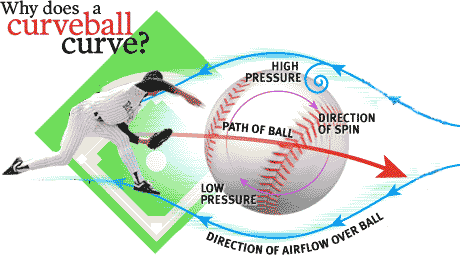 http://ffden-2.phys.uaf.edu/211_fall2002.web.dir/jon_drobnis/images/pics/curveball.gif |
The curveball deceives the
batter by diving rapidly downward just as it
reaches home plate, and it is typically thrown
between 10 mph and 20 mph slower than the average
fastball, or between 75 mph and 85 mph. The
concept of drag, or air resistance, is crucial
when considering the motion of a curveball. The
drag force on a moving object can be described by
the equation D=(1/2)C*ρ*A*v2,
where C is the drag coefficient (approximately 0.5
for a baseball), ρ is the density of air, A is the
cross-sectional area of the object, and v is the
object’s speed. The Magnus Effect easily explains the curveball’s motion. This is the same principle that keeps an airplane in flight, and is commonly called lift. The wings of an airplane force air flowing over the wings to move faster so as to keep up with the uninhibited air flowing below the wings. This means air pressure is lower on top of the wing. Thus the higher pressure under the wing pushes the wing up and creates lift. When applied to a baseball, spin is everything. Throwing a curveball creates topspin, meaning that air flows faster under the ball and has lower pressure. In this case, the Magnus Effect amplifies gravity, causing the ball to drop rapidly. |
https://encrypted-tbn0.gstatic.com/images?q=tbn:ANd9GcStwHEA_Vrevfcl8t0Kle2ATEnyh99Mn7gtYfkwf0uJRk2U-pm0fg |